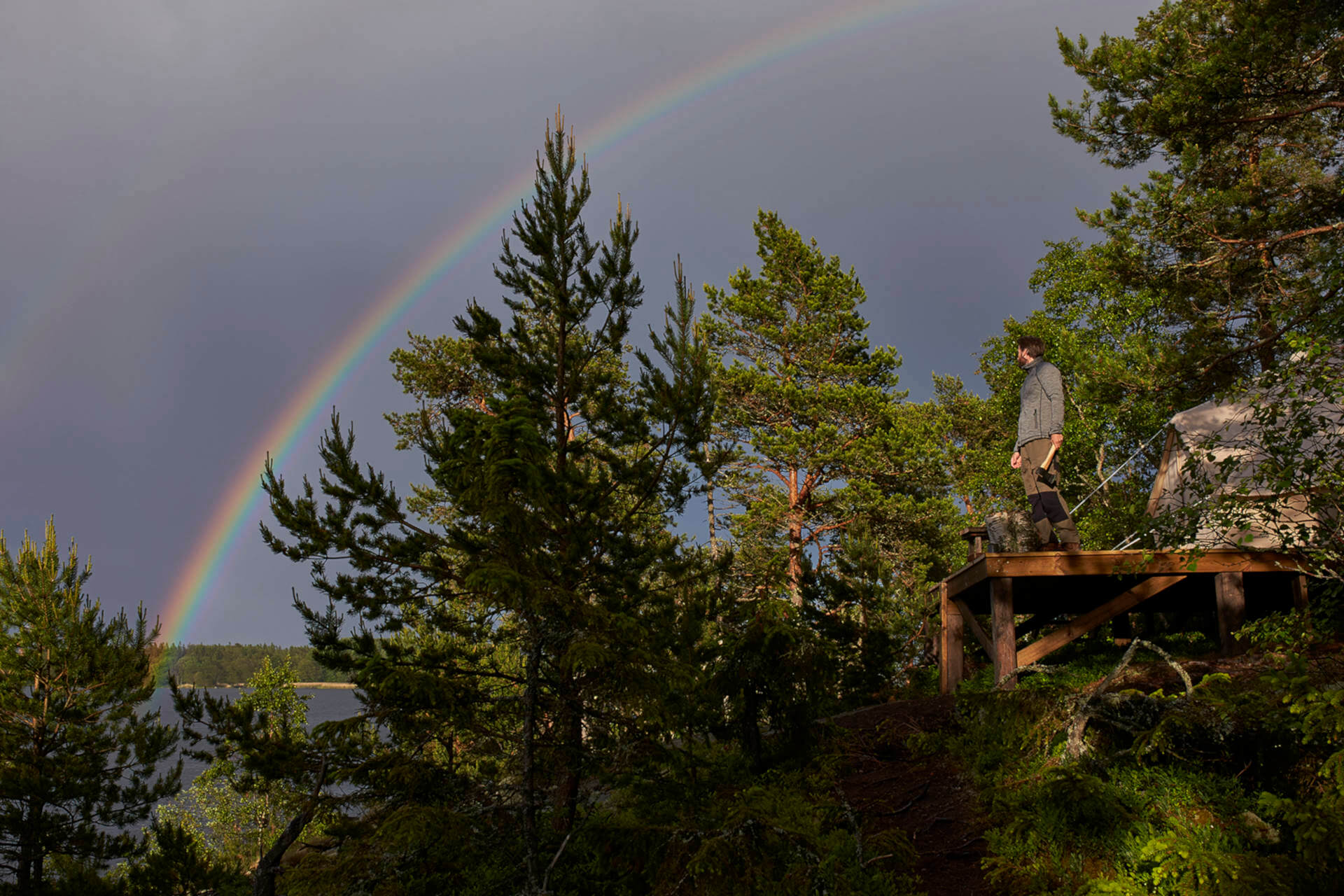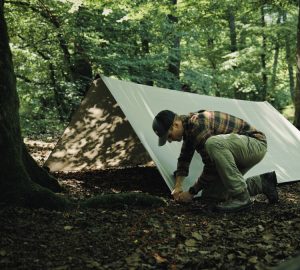The sky is darkening, the clouds are growing bigger and within fifteen minutes a violent thunderstorm is going to explode above you – a quite common scenario during summer time. For those of you who happen to be outside camping during such weather conditions the following rules of behavior might be important. Together with our colleague and outdoor expert Michael Bösiger we’ll explain what to keep in mind when sleeping in a tent during a thunderstorm.
In summer, such brutal heat thunderstorms can swiftly occur in the mountains. These thunderstorms are usually accompanied by heavy rainfall, wind gusts and hail. If you are forced to sleep in a tent in such a situation it is crucial to look out for an appropriate spot offering enough protection – not only from lightning strikes.
You shouldn’t underestimate the chances of being hit by lightning. Still, it’s essential to keep a thunderstorm’s additional hazards in mind: windstorms can easily destroy your tent and tear it off the ground. Heavy rainfalls can flood it and make it moist. If worst comes to worst torrents or even landslides can come down the mountainside. You are to thoroughly consider all these things if signs of a thunderstorm catch your eye.
Tatonka tip: The most important rule is to constantly observe the weather. Look up the weather forecast beforehand and, from time to time, keep checking whether there’s a change of conditions. If you’d have any doubt about it, you better turn around or find yourself a safe place in time. Even though it appears like there’s friendly and warm weather, you’d never leave home without rainproof and warm clothing. Especially in the mountains, thunderstorms mostly involve heavy drops of temperature.

Take cover: during thunderstorms a tent is no safe place
If possible, you should – especially in the mountains – try to seek shelter in a solid building, like an alpine hut, as a thunderstorm is approaching. A vehicle, if nearby, could be used as a safe place as well. A tent, on the other hand, offers no protection from lightning at all.
Compared to a car a tent can’t work as a faradic cage, which is able to carry the electricity from its surface into the ground surrounding. If a lightning bolt hits a tent the energy will unevenly be discharged through the tent’s frame into the soil. Therefor, the energy jumps or breaks through the isolated spots. Consequently, electric potential accumulates in the soil beneath – dangerous step voltage is the result.
If there’s people nearby the tent’s frame, whose bodies are better connected with the ground than the tent’s poles, there can be the danger of unloading sparks. This is life-threatening since electricity would run through the body.
As we can see, a tent is no protection against lightning. If you can’t find any shelter at all – on a trekking tour for example – the right campground and appropriate rules of behavior are paramount.
Also interesting: Tips from outdoor-professional Michael Bösiger on how to bivouack
Encampment – which spot is least perilous during thunderstorm
To reduce the possibility of being hit by lightning you need to consider a few important aspects for your encampment.
Avoid exposed places like hills, mountain crests or river banks.
Also at the edge of the forest or under free-standing trees, you should not open your tent at risk of thunderstorms under any circumstances. Within a densely grown forest, on the other hand, the risk of being hit by lightning isn’t any higher than in other places.
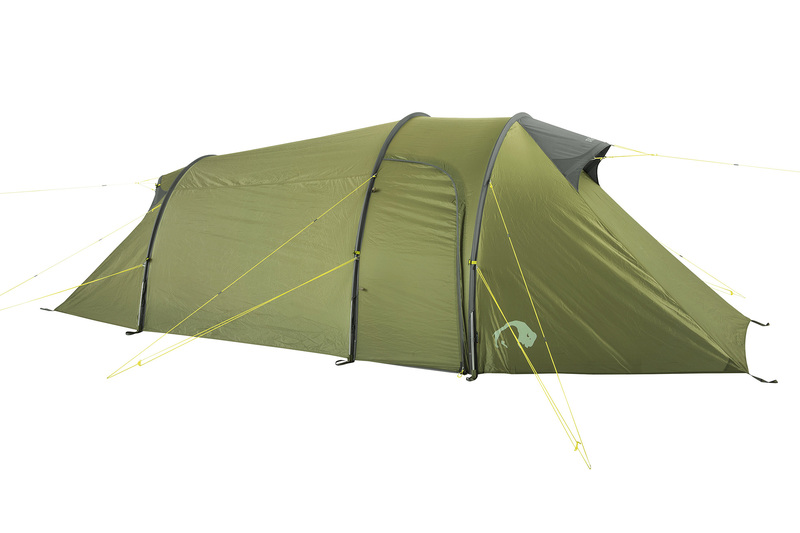
High quality tents by Tatonka
In our online shop you will find tents in different sizes and designs.
If there’s not enough time to find a proper place for your camp or the thunderstorm is already too close, it can make sense to not pitching you tent at all. Maybe you can find an alpine hut, a ledge or a cave to endure the storm in.
Crucial: metal equipment like hiking poles, piolets, climbing irons, carabiners, but also cookware like cookers, pots or mugs can attract lightning. Store them a few meters apart water-tightly packed in a safe spot. Same goes for being close to a via ferrata: the iron ladders and ropes carry electricity particularly well. Always keep safe distance!
Also interesting: How to make fire in the wild
Avoid oaks, look for beeches?
The common theory that in case of a thunderstorm people are to seek cover under an oak tree is utter nonsense. All kinds of trees do equally attract lightning.
Though the lightning’s impact on the trees can differ: an oak’s rugged, thick bark contains more water than others. The fluid spreads over a large surface. If a lightning bolt should hit it, the damage usually looks devastating.
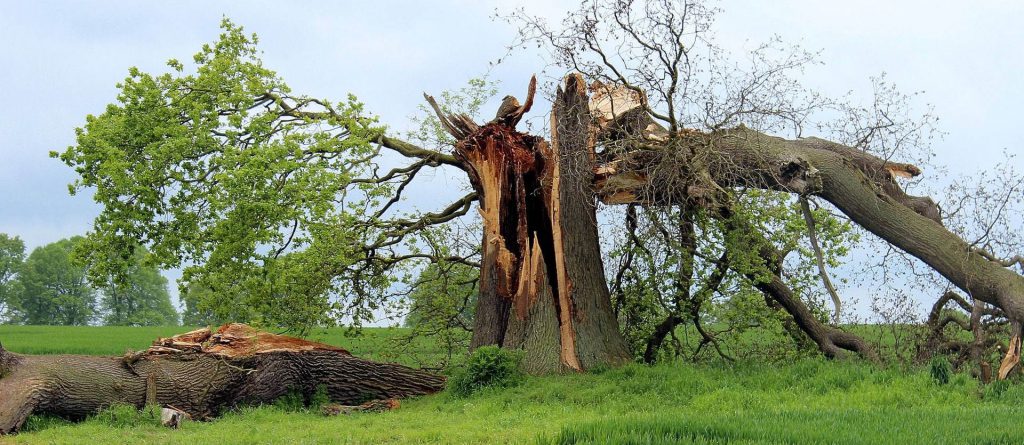
On a beech’s level bark, the water simply runs down the surface to the ground. This carries the lightning directly into the soil without causing any obvious damage. Anyway, the peril for those taking cover is equally high below both kinds.
What you should also avoid are power poles and high-voltage lines.
Also intersting: Which tent type are you?
How to behave in tent during thunderstorm
If it’s too late leaving the tent for a safe place, you want to consider the following:
- Don’t touch the tent’s frame or cover. Try to stay in the very middle of it.
- Sit in a squatted position as compact as possible. Touching the ground only on one spot can prevent you from being electrocuted (step voltage).
- Never sit on the bare ground. A dry air mattress, a several folded camping mat or your backpack might help to enhance insulation making you less grounded – and keep your hiking boots on.
- Get rid of any wiring leading into the tent.
Safeguard your tent properly – not only against lightning
Next to lightning there’re other hazards you and your tent needs to be protected from: heavy rainfalls and squalls.
- Strong winds and squalls
On the one hand, your tent should be protected against wind. On the other hand, those alleged safe places involve other dangers. You’d avoid trees by all means. Branches could break loose and fall onto your tent. In addition, be aware of dead wood in the trees around which could easily drop down. In the worst case the whole tree gets rooted out. If you are aware of the wind direction in the area around, pitch your tent that way providing the smallest target.
- Heavy rainfall during thunderstorm
A vast amount of water might also do harm to you and your tent. In a depression accumulated water can flood your tent and soak both your luggage and sleeping bag.
Additionally, you better avoid floating water or dried out creek beds. Heavy rainfall can change a creek bed to a torrential river which – in the worst case – can tear away your tent.
Moreover, check cliffs and slopes nearby closely before pitching your tent. In case of a thunderstorm landslides or rockfalls are possible too. Ask yourself beforehand where the water could come from and where it would go.
Guessing the thunderstorm’s distance
How to know the thunderstorm’s remoteness? There’s one simple rule: simply count the seconds between lightning and thunder. Multiply this number by 342 (sonic speed). The result is the thunderstorm’s distance away in meters.
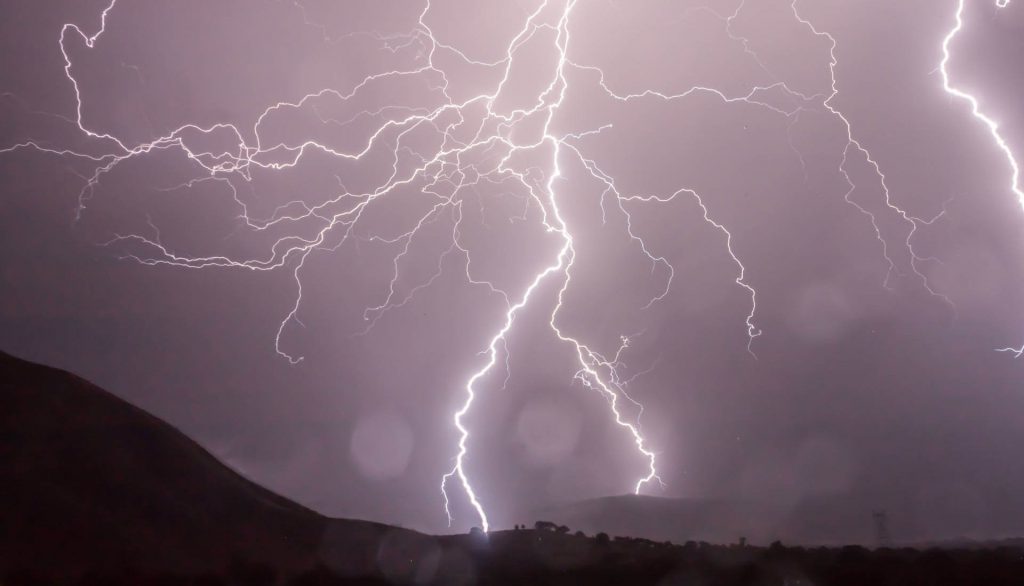
For example: there’s 3 seconds time between lightning and thunder, which means the thunderstorm is, approximately, about 1 kilometer away. That means at 5 seconds or less, it becomes dangerous.
Yet, sometimes lightning can be a few kilometers ahead of the thunderstorm. If the storm is not coming your direction, you’re safe as soon as you can count 20 seconds between lightning and thunder minimum. Until then, there’s nothing else to do than to keep calm and to consider everything mentioned above. And, if you’re lucky, the thunderstorm will be gone as swiftly as it has approached.
Here are some more examples:
9 seconds between lightning and thunder: the thunderstorm is about 3 kilometers away = the situation is harmless.
6 seconds between lightning and thunder: the thunderstorm is about 2 kilometers away = the thunderstorm comes closer
3 seconds between lightning and thunder: the thunderstorm is about 1 kilometer away = it is getting dangerous.
1 second: the thunderstorm is about 300 meters away = seek for shelter and follow the above instructions.
Also interesting: Never been on a trekking tour? The 5 most common beginner’s mistakes and how to avoid them




